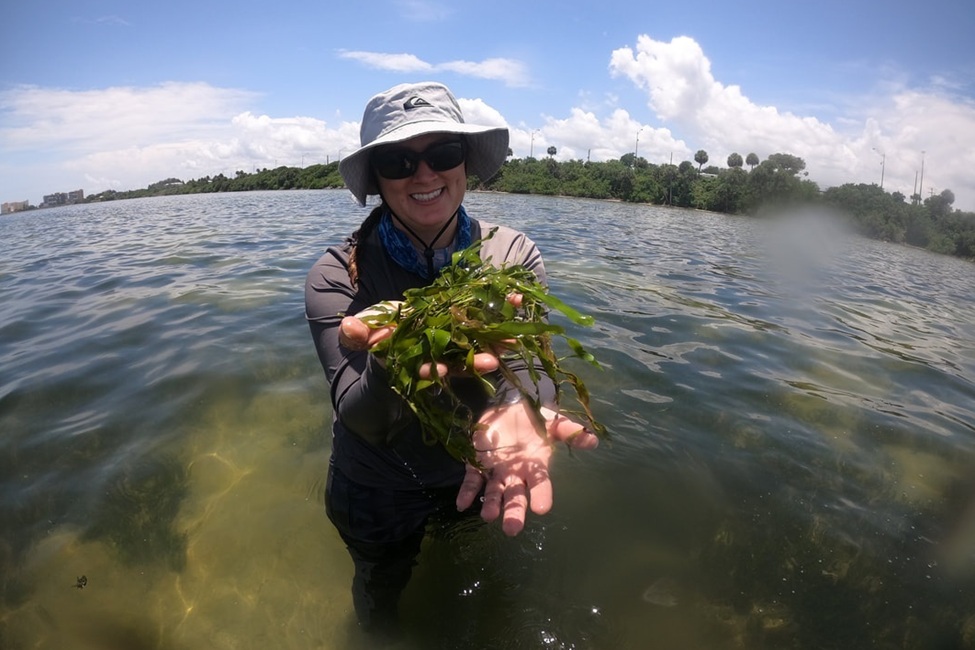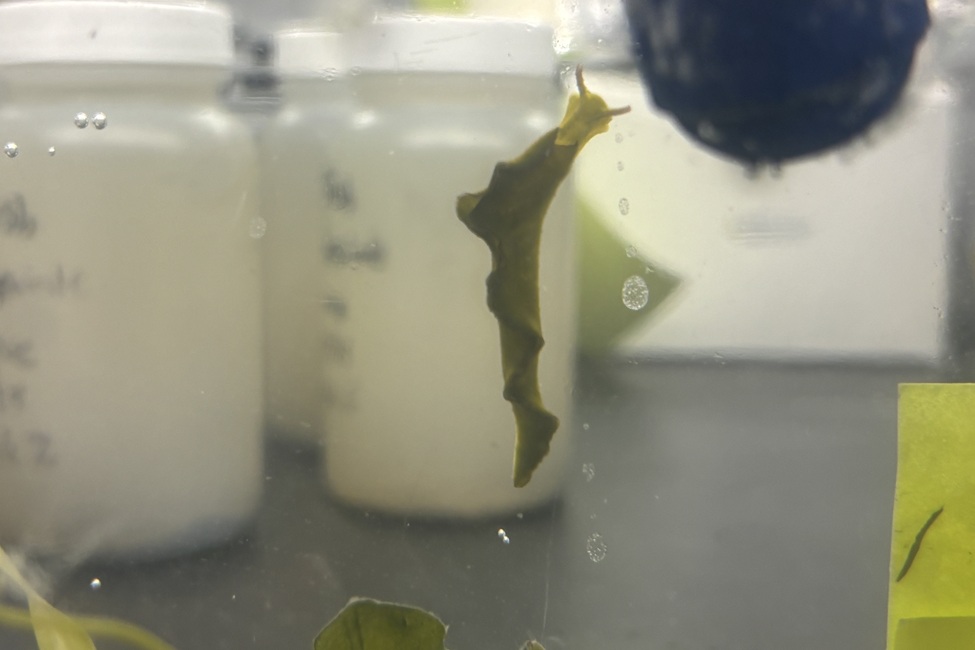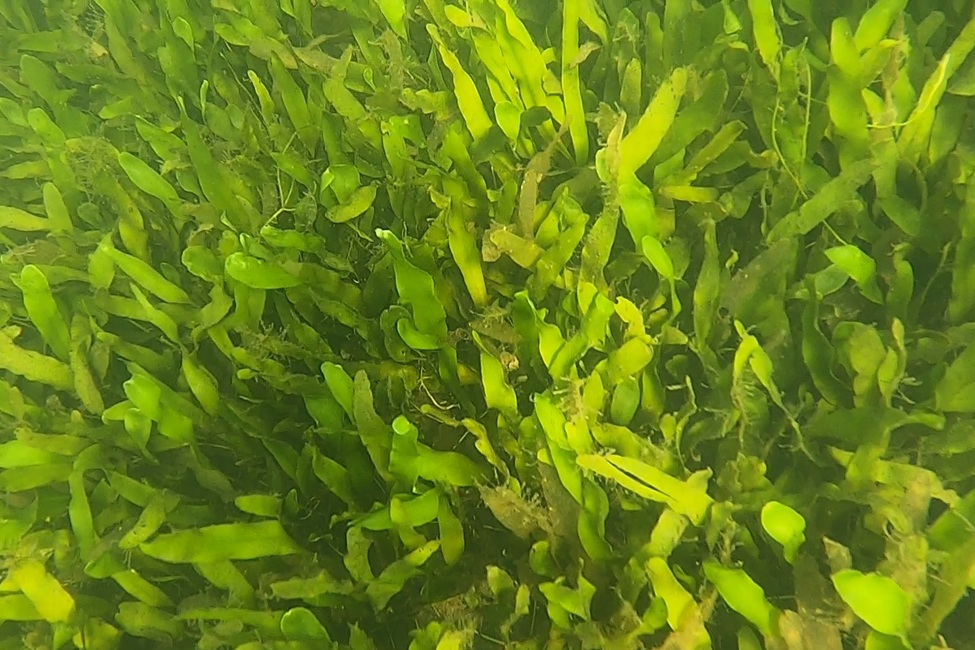Green Seaweed Replaces Seagrass, But Sea Slugs Pose New Threats

Rachel Brewton, Ph.D., senior author, holding the green seaweed Caulerpa prolifera in Florida’s Indian River Lagoon in 2021 during the study period.
Seagrasses are critical to coastal ecosystems – offering habitat, stabilizing the seafloor and buffering wave energy – but globally they’re increasingly under threat. Beginning in 2011, a series of intense algal blooms – fueled by pollution and nutrient overload – wiped out vast stretches of vital seagrass beds in Florida’s Indian River Lagoon (IRL).
In the wake of this collapse, the fast-growing green seaweed Caulerpa prolifera has spread across areas once dominated by native seagrass species like Halodule wrightii, filling in the empty seabed. The IRL is home to seven seagrass species, which historically covered most of its sandy bottom, so seaweed becoming the dominant seafloor cover represents a major ecological shift.
As this pollution-tolerant macroalgae replaces seagrass, it may be reshaping marine life and reducing biodiversity. Although scientists studied C. prolifera’s habitat value in the 1980s, its current role remains unclear. Could this opportunistic green algae now provide a lifeline for marine species in a changing ecosystem?
Researchers from Florida Atlantic University’s Harbor Branch Oceanographic Institute surveyed the small animals living in and around this green seaweed in the lagoon between 2020 and 2021 during a period of extreme seagrass scarcity. They studied four sites, measuring both seaweed cover and the diversity of marine life. Their goal: to assess how effectively C. prolifera supports marine communities in the absence of seagrass.
Published in Marine Biology, results reveal that C. prolifera coverage on the lagoon floor varied over time. The small animals living within these beds were similar to those historically found in seagrass beds, but their abundance was notably lower – an important insight for resource managers focused on habitat quality and ecosystem recovery in the IRL.
“Results from our study suggest that there has been a noticeable decline in the number of marine animals typically found in seagrass habitats,” said Rachel Brewton, Ph.D., senior author and an assistant research professor, FAU Harbor Branch. “Our research zeroed in on the smaller, resident species that are critical to the ecosystem. This shift in focus reveals just how much these vital species have been affected.”
Researchers also discovered that red drift algae – collected incidentally – supported many of the same species as C. prolifera, suggesting it may also provide valuable habitat. In the absence of seagrass, both types of macroalgae could serve as temporary refuges for estuarine life, though with fewer animals than in the past. These findings may help guide restoration efforts in other regions affected by seagrass loss and rising macroalgal blooms.
“One concern for resource managers is that Caulerpa prolifera might pose risks to animals that rely on it for food or shelter,” said Brian Lapointe, Ph.D., co-author and a research professor at FAU Harbor Branch. “This algae contains a toxin, caulerpenyne, which can harm certain species like sea urchins and mosquito fish. While many animals avoid eating it, there’s evidence that manatees, whose diet shifted from seagrass to macroalgae after seagrass loss, suffered from malnutrition and lethal infections. Similarly, the decline in seagrass was linked to stress in bottlenose dolphins, as it affected the availability of their preferred prey.”
Following this study of C. prolifera dominance in the IRL about five years ago, the researchers recently noticed something very interesting – sea slugs called Elysia subornata.
“These small, green sap sucking sea slugs have become very numerous in the lagoon,” said Brewton. “The complete decimation of a C. prolifera bloom in the lagoon during the late 1980s was previously attributed to these slugs, and now, we have seen them eliminate the cover at one of our study sites at Turkey Creek. We’re currently monitoring their expansion at another site from this latest study in the journal, Marine Biology, to document how they spread and how quickly they can consume a C. prolifera meadow.”
Emory Tudor, an FAU Harbor Branch Link Foundation summer intern, became interested in how these tiny slugs might facilitate major ecosystem shifts and will be studying their feeding rates and observing their development in the lab over the next month.
“If these slugs eliminate C. prolifera beds again, the consequences for local fisheries could be dire, although this decline might also create opportunities for seagrass recolonization,” said Tudor. “Understanding how these slugs move and how quickly they consume C. prolifera will be critical in the coming months if their spread continues.”
The researchers say that given the global decline in seagrass, further research on macroalgal habitats and their role in supporting fish populations is crucial, especially in places like the IRL. In addition, improving wastewater treatment and stormwater management to reduce nutrient pollution should continue to be a key focus for protecting the lagoon’s health.
“While Caulerpa prolifera has offered some temporary hope as a habitat substitute in the absence of seagrass, there is still much we don’t know,” said Brewton. “We need to better understand the long-term impacts of these algae blooms, including their effects on water quality, faunal populations and the potential for seagrass recovery. As these blooms continue to play a role in the ecosystem, more research is needed to fully grasp how they affect the lagoon and its wildlife. For example, these changes may be negatively impacting sportfish populations.”
This work was supported by the Harbor Branch Oceanographic Institute Foundation through the Florida Center for Coastal and Human Health and the Indian River Lagoon Graduate Research Fellowship program (2019-22).

A photo taken last month of a small, green sap-sucking sea slug retrieved from the Indian River Lagoon.

A close-up of the green seaweed, Caulerpa prolifera, in Florida’s Indian River Lagoon taken in 2021 during the study period.
-FAU-
Latest News Desk
- Theatre Lab Begins Second Decade of Programming New WorkTheatre Lab announced its 2025-26 season, marking the start of its second decade of programming.
- FAU's Amy Wright, Ph.D., Honored for Marine Drug Discovery ResearchFAU Harbor Branch researcher Amy Wright, Ph.D., has received the prestigious Norman R. Farnsworth ASP Research Achievement Award, the highest accolade presented by the American Society of Pharmacognosy (ASP).
- FAU Joins VIP Consortium, Launches Inaugural Research TeamsFAU is the first university in Florida to join the international VIP Consortium, a global network of more than 50 institutions of higher education, and has selected its first official VIP teams.
- College of Nursing Receives $1.8M Gift from Mark Bruce SwillingerFAU's Christine E. Lynn College of Nursing has received a $1.5 million gift from Mark Bruce Swillinger in memory of his wife, Marilyn Lee Swillinger.
- FAU Engineering Awarded USDA Grant for Smart Farming BreakthroughThis groundbreaking, multi-institutional research project is aimed at revolutionizing the future of precision agriculture through the development of an advanced edge/fog computing-based framework.
- New FAU-USF Research Rewrites Origins of the World's First PandemicFor the first time, FAU-USF researchers have found direct genomic evidence of the Plague of Justinian in the Eastern Mediterranean, where the world's first recorded pandemic began nearly 1,500 years ago.






